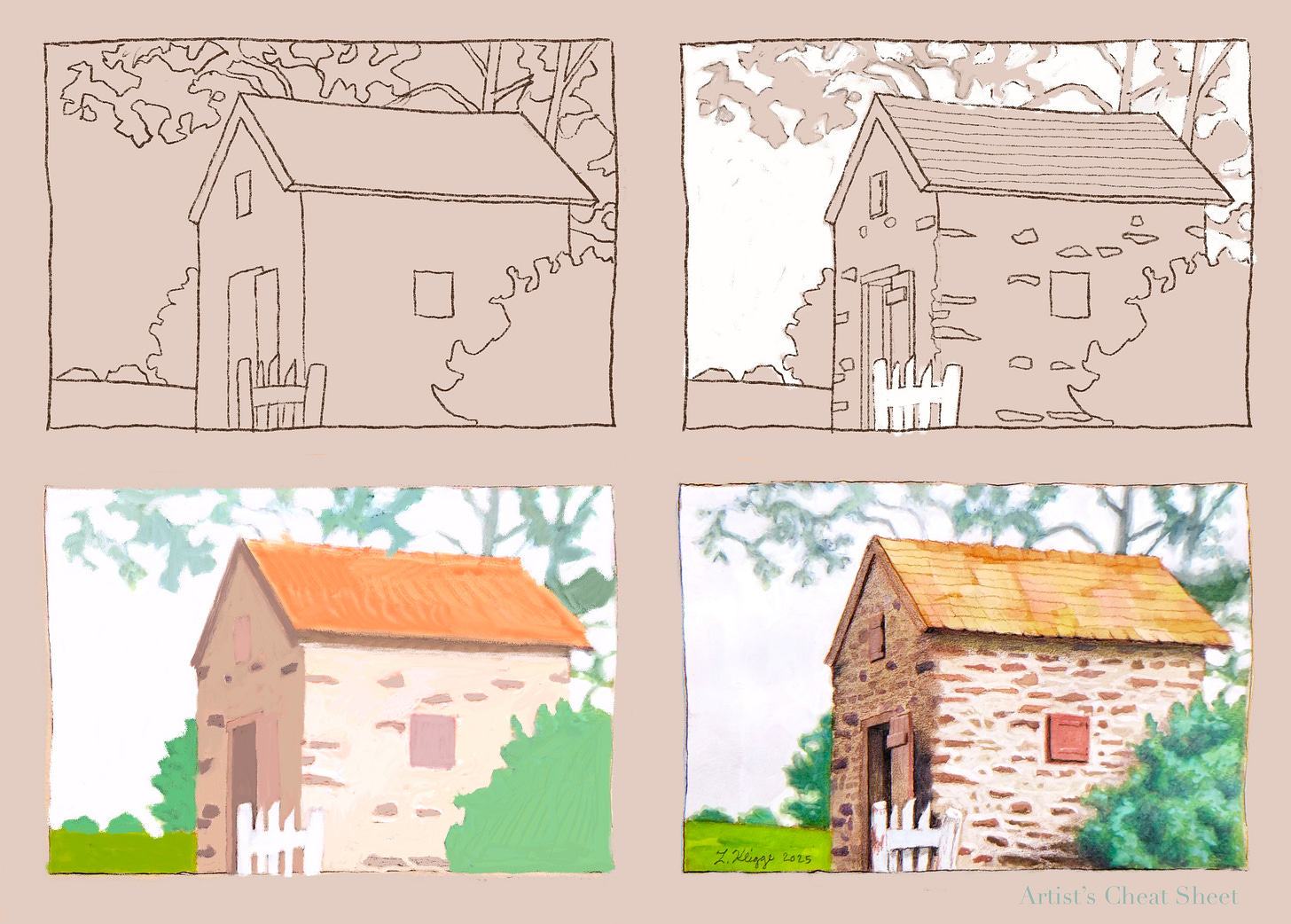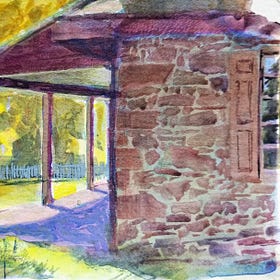This sketch of the smokehouse at Daniel Boone Homestead in Exeter Township, PA was done on a hazy, humid day at the end of June. I used a combination of watercolors, gouache, colored pencils, and pen on this four-hour study.
The Boone House
A tour group came through with a historical reenactor named Barie who was dressed in period-appropriate, 18th century garb. He even wore a tricorn hat on his head. Linda and I were sitting on the porch of the Boone house, and we had just begun our sketches of the nearby smokehouse.
Barie explained to his audience how an earlier log cabin (that colonial American settler Daniel Boone would have known) was replaced with a two-story home made of stone. “If you look at how the stone changes size below this line, to the left of the porch, that’s the portion the Boones would have seen on an everyday basis. The iron-rich rock of this area produces the reddish color seen in the walls.”
As they made their way inside, some of the group members peeked at our sketchbooks, setting into motion a pattern of curiosity that continued throughout the day. Linda and I spoke to people who had come in from miles away, and even other states, and everyone was universally generous with praise for our sketches.

The smokehouse
At one time the historic smokehouse would have preserved and flavored meat proteins for the settlers living at the homestead. Today, the structure serves as an educational tool and a window into days gone by.
The stone walls of the smokehouse are covered in a cream-colored render, with dark reddish or blackish stones peeping through here and there, and the roof is of an orange-colored tile. The door and painted trim is a chocolate brown color. I thought a tan paper with mixed media would impart a warm feeling and allow me to explore a variety of textures (wood, stone, foliage).
My sketch process
I used a water-soluble brown pencil on Strathmore Toned Tan sketch paper and marked out major proportions, paying just enough attention to perspective, and allowing areas with different amounts of density to contrast.
Then I separated the major sections of light and dark. Since this was tan paper, I was able to begin with white gouache.
I continued filling the major shapes with simple color, and used a few dominant stones to help me place others on the wall.
In the last stage I modeled flat shapes into dimensional forms, added textures with paint and colored pencils, softened edges where I don’t want attention drawn, and deepened contrast and sharpness where I do want the viewer to look. I signed the picture and added a few notes about where I was and who I was with.
The basic setup was a tripod with a homemade, Gurney-style easel, some paints and pencils, and a sketch pad clipped to the easel.
Read another post about sketching at Daniel Boone Homestead:
Fifteen Tips for Sketching Historic Locations
This past weekend I had the pleasure of guiding a sketch group at the Daniel Boone Homestead in Exeter Township, Pennsylvania. Here are tips for observational sketching at historical sites.
More workshops coming up!
Don’t be shy this summer! Join me for a sketch workshop!
July 9, 2025–Sketch in the beautiful new courtyard at GoggleWorks in Reading, PA. $59.50
July 12, 2025–Let’s paint like the beloved mid-century illustrator Mary Blair, at Historic Yellow Springs in Chester County, PA. $75
July 26, 2025–Sketch with me at historic Gruber Wagon Works in Berks County, PA. A tour of the museum is included! $30
Yes, it’s time for fun in the sun—I hope to see you there!








Loved the irregular representation of the small white fence in the middle of the sketch. That little bit of "reality" really adds to this little sketch. So often I have got busy on a repetitive part of a work, and made it dull and boring because I left out a bit of reality that gave spark to a scene. This was a good reminder.
I am really drawn to the roof (no pun intended ... I think). I dig how you rendered it. Took notes.